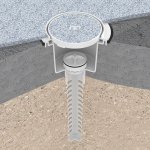I hate to make a new account on a forum and make a thread immediately, but I did a few permutations of searches and didn't pull up anything that would answer my question/address my concerns. If someone reading this then does a search and pulls up an exact match to this thread with answers, I apologize.
New-ish pool owner, bought a house with a pool! Kept the pool guy the previous owners was using! I ditched him after a year and found out my levels were out of whack! 450 ppm CYA! 300 ppm Total Alkaline! Yikes!
So a drain is in process. However, I am scared of pool popping after seeing lots of horror stories about it. Did some reading and I should pop a hydrostatic valve as soon as I can, but when? Should I wait until the water level drops below the level of the pump? Or when it's at a foot high? My concern is I don't do it in time. I definitely need to get the water level down as much as possible since even a puddle in the pool would mix in enough CYA to be normal.
But then again, I'm in Vegas... the desert. The water table can't be that high. My boss has drained his pool multiple times and said "What's a hydrostatic valve?" with no issues. My ding dong neighbor had a swamp last year, drained his and never refilled it and it didn't lift out of the ground (and I'd bet solid cash he didn't pop his valve). Do I even need to pop mine? It hasn't rained here in at least a month and it was a drizzle. Then there's me, the klutz, trying to open the valve and possibly damaging the pool.
I assure you I am not this paranoid in real life. A $30k pool repair bill is freaking me out, I will admit.
I'm having it refilled tomorrow afternoon - it'll be 4 hours tops before it's refilled after the drain is finished. I guess I just need someone to tell me to relax. Thanks in advance.
New-ish pool owner, bought a house with a pool! Kept the pool guy the previous owners was using! I ditched him after a year and found out my levels were out of whack! 450 ppm CYA! 300 ppm Total Alkaline! Yikes!
So a drain is in process. However, I am scared of pool popping after seeing lots of horror stories about it. Did some reading and I should pop a hydrostatic valve as soon as I can, but when? Should I wait until the water level drops below the level of the pump? Or when it's at a foot high? My concern is I don't do it in time. I definitely need to get the water level down as much as possible since even a puddle in the pool would mix in enough CYA to be normal.
But then again, I'm in Vegas... the desert. The water table can't be that high. My boss has drained his pool multiple times and said "What's a hydrostatic valve?" with no issues. My ding dong neighbor had a swamp last year, drained his and never refilled it and it didn't lift out of the ground (and I'd bet solid cash he didn't pop his valve). Do I even need to pop mine? It hasn't rained here in at least a month and it was a drizzle. Then there's me, the klutz, trying to open the valve and possibly damaging the pool.
I assure you I am not this paranoid in real life. A $30k pool repair bill is freaking me out, I will admit.
I'm having it refilled tomorrow afternoon - it'll be 4 hours tops before it's refilled after the drain is finished. I guess I just need someone to tell me to relax. Thanks in advance.




